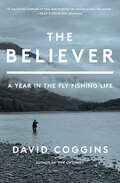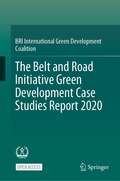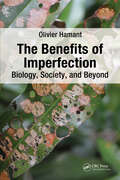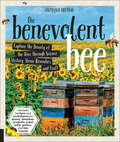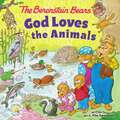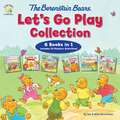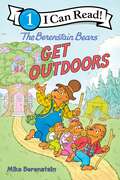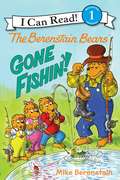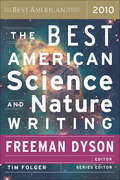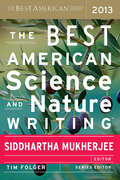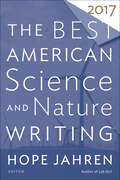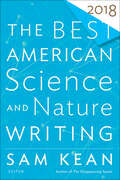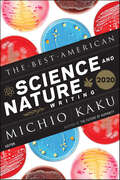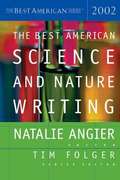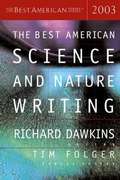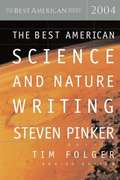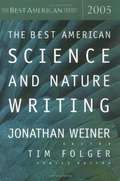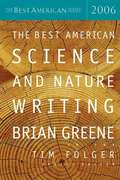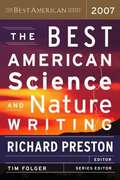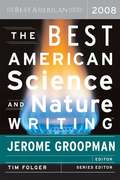- Table View
- List View
The Behavior of Texas Birds
by Kent RylanderWhether it's the sudden, plunging dives of Brown Pelicans, the singing and aerial displays of Northern Mockingbirds, or the communal nesting of Purple Martins, innate and learned behaviours are some of the most fascinating things to observe in Texas birds. Even casual birdwatchers eventually ask, ""why do they do that?"" while serious birders and ornithologists seek to understand all the behaviours involved in feeding, flying, mating, and rearing young. But until now, it has been hard to find this information in one handy source. In this comprehensive, yet easy-to-use book, Kent Rylander distils data from many sources to provide an authoritative guide to the behaviour of Texas birds. He begins by explaining the principles of animal behaviour and illustrating how they can be applied to interpreting bird behaviours in the field. The majority of the book is devoted to accounts of more than 400 species of birds that are most likely to be encountered by Texas birdwatchers. Each account describes such behaviours as feeding, courtship, parenting, and other behaviours that are significant for that species.
The Behavioral Biology and Conservation of Goitered Gazelles (Gazella subgutturosa)
by David BlankThis comprehensive and lavishly illustrated book summarizes all known information on the Goitered Gazelle (Gazella subgutturosa), one of the world's most endangered antelopes. It includes information on topics such as feeding ecology, behavior, vocalizations, parasites and diseases, and conservation. This research monograph will be of interest to professional researchers of ungulates, university staff, students, and naturalists.
The Believer: A Year in the Fly Fishing Life
by David CogginsThe author of the instant fishing classic The Optimist shares new wisdom, humor, and experience in seven extraordinary fly-fishing expeditions—&“an engaging personal journey about finding what you need to find and keeping it in your heart&” (Kirkus Reviews).In The Optimist, David Coggins tackled the techniques of fly-fishing and meditated on its virtues, recounting his triumphs and failures. Now, in The Believer, he deftly mixes travel, local cultures, further fishing challenges (some knee-buckling in their disappointment), and details his own experience as life and love crowd his time to fish. Self-consciously—and self-deprecatingly—Coggins embarks on seven far-flung fishing voyages, away from screens and social media, not answering his phone, and reveling in humanity&’s undying yearning for a quest, for the rituals and rites of passage that mark transition. For Coggins, these journeys—to Norway, Scotland, Spain, Cuba, and Argentina, as well as road trips to Wyoming, Tennessee, and the Catskills—not only showcase his skill as an angler but also signal the end of his fly-fishing youth. But that doesn&’t mean that Coggins will sell all his rods and hang up his hat; rather, his relationship with his fly-fishing obsession will evolve—especially if he can catch an elusive salmon or a ferociously strong tarpon or the mercurial permit. The Believer is a humble, humorous call for the journey that is as enriching as the destination, where the search for greater self-awareness leads to patience, observation, and endurance. And, since this is fly-fishing, after all, there&’s always the possibility of abject failure and leaping, glorious reward. Wry, entertaining, thoughtful, and relatable, The Believer is &“a wonderful example of how well angling can weave us into the world&” (Gray&’s Sporting Journal) and will hook both anglers and non-anglers alike.
The Bella Helps Increase Pollination: (a climate-conscious children's book) (The Little Helpers)
by Claire Culliford Emma AllenA new series of climate-conscious children's books.Bella is a bee. Bella’s grandma, Bonnie, is a queen bee. Bella notices there aren’t as many flowers in the garden as there used to be and the ones which are there are dry and wrinkled containing very little nectar. How can Bella help the flowers grow? What can she do to make more honey?Bella Helps Increase Pollination is part of the Little Helpers series, written to support the United Nations’ Sustainable Development Goals. With fantastic, colourful animal characters, the stories show children how helping each other and their environment can be lots of fun!PRAISE FOR THE LITTLE HELPERS SERIES“Engaging and educational” People's Trust for Endangered Species“Wonderful” Peter Hylands, President, Australian Wildlife Protection Council“Truthful and inspiring” Emma Girvan, PR and Communications, The Australian Koala Foundation“Beautiful” Anne Rowberry, Chair of The British Beekeepers Association“Educates and inspires” Iglika Trifonova, Chair of APECS Bulgaria“Fun and engaging” Jason McCartney, MP for Colne Valley“Really engage[s] children and provide[s] a platform for them to explore some really big questions” Debbie Kelly, Principal, Beaumont Park Academy“We love Claire’s characters” Rufus Bellamy, Manager, David Bellamy Conservation Award Scheme“Fun and accessible” Joe Eisen, Executive Director of the Rainforest Foundation UKTHE LITTLE HELPERS SERIESHector Helps Clean up the ParkPenny Helps Protect the Polar Ice CapsTyler Helps Find a New HomePaula Helps Prevent Air PollutionKati Helps Avoid HungerBella Helps Increase PollinationEddie Helps Locate WaterPan Pan Helps Shelter From Acid Rain
The Belt and Road Initiative Green Development Case Studies Report 2020
by BRI International Green DevelopmentThis is an Open Access book. In accordance with the 2030 Agenda for Sustainable Development, it showcases 17 projects under the framework of Belt & Road Initiative (BRI). These projects cover ninefields, namely, biodiversity and ecosystem, clean energy, clean water, sustainable transportation, solid waste treatment, sustainable consumption and production, green buildings, sustainable foodproduction and corporate social responsibility. Aiming at achieving green development, these projects, in their implementation, adhere to the concept of ecological civilization, combine China’s strict environmental protection systems and international standards, and take various measures of environmental protection based on the conditions of the local environment. These measures include joint efforts with local governments, businesses and communities, optimizating of design and construction plans, strict controling over different types of pollutants, and in situ conservation of species and ecosystems.The experience and practice of these 13 projects set an example for the latecomers.
The Benefits of Imperfection: Biology, Society, and Beyond
by Olivier HamantThe cult of performance leads our society to emphasise the values of success and continuous optimisation in all areas. Slowness, redundancy and randomness are therefore negatively perceived. Olivier Hamant, in his book, reclaims them by his knowledge of biological processes.What can we learn from life sciences? While some biological mechanisms certainly boast formidable efficiency, recent advances instead highlight the fundamental role of errors, incoherence or slowness in the robustness of living organisms. Should life be considered suboptimal? To what extent could suboptimality become a counter-model to the credo of performance and control in the Anthropocene?In the face of pessimistic observations and environmental alerts, the author outlines solutions for a future that is viable and reconciled with nature.Key Features: Solidly documents with a grounding in scientific facts focusing on solutions Explores a pragmatic way towards robustness, moving the debate beyond performance, technolatry or degrowth Responds to eco-anxiety by providing an engaging and viable way forward
The Benevolent Bee: Capture the Bounty of the Hive through Science, History, Home Remedies, and Craft
by Stephanie BruneauA beekeeper and herbalist shares how you can use six products of the beehive: honey, pollen, propolis, royal jelly, beeswax, and bee venom. Not all new beekeepers realize that a honeybee hive produces a lot more than just honey. While your hard-working ladies will produce delicious honey, the hive as a whole also produces pollen, propolis, royal jelly, beeswax, and bee venom; all very useful things for humans, if we know how to use them.The Benevolent Bee describes how and why the bees make these products, how they&’ve been used by humans throughout the ages, and how beekeepers can harvest the products. It also presents simple do-it yourself recipes for using the products in health and wellness, body care, nutrition, and craft. You'll learn how to make salves for burns and a cough syrup from raw honey; how to make a tincture, an infused oil, and a mouthwash from propolis, the anti-bacterial &“bee glue&” that lines the inside of the hive; and much more. Get crafting now, it&’s all already in your hive!
The Berenstain Bears God Loves the Animals (Berenstain Bears/Living Lights: A Faith Story)
by Jan Berenstain Mike BerenstainToddlers and preschoolers will enjoy reading about God&’s beautiful creation in this addition to the Living Lights™ series of Berenstain Bears books. This board book fits perfectly into little hands and highlights animals that live and share Bear Country with Mama, Papa, Brother, Sister, and Honey Bear.The Berenstain Bears God Loves the Animals—part of the popular Zonderkidz Living Lights series of books—is perfect for:? Teaching children ages 0–4 how to recognize animals and their features with a point and learn format that includes bolded animal vocabulary on each page? Reading out loud at home or in classrooms? Sparking conversations about protecting animals and their natural habitats, and the importance of respecting the earth and protecting God&’s creaturesThe Berenstain Bears God Loves the Animals:? Features the hand-drawn artwork of the Berenstain family? Continues in the much-loved footsteps of Stan and Jan Berenstain with this Berenstain Bears series of books? Is part of one of the bestselling children&’s book series ever created, with more than 250 books published and nearly 300 million copies sold to date
The Berenstain Bears Let's Go Play Collection: 6 Books in 1 (Berenstain Bears/Living Lights: A Faith Story)
by Mike BerenstainGet outside and play with the Berenstain Bears! This high-value, six-book collection encourages young readers to get out and explore God&’s wonderful world, with inspiring stories filled with adventure, laughter, and fun. The Berenstain Bears Let&’s Go Play Collection—part of the bestselling Zonderkidz Living Lights™ series—also features helpful instructions and tips for ten timeless games and activities, including hopscotch, camping, capture the flag, and more!Join the Berenstain Bears as they explore the value of teamwork, active play, and a love of the great outdoors in The Berenstain Bears Let&’s Go Play Collection. With six beloved stories and ten activity suggestions, this affordable and giftable treasury for children ages 4-8 is perfect for classrooms, summer reading, story time, or anytime!The Berenstain Bears Let&’s Go Play Collection includes six classic favorites:The Berenstain Bears Faithful FriendsThe Berenstain Bears God Made You SpecialThe Berenstain Bears Why Do Good Bears Have Bad Days?The Berenstain Bears Honesty CountsThe Berenstain Bears Play a Good GameThe Berenstain Bears God&’s Wonderful World The Berenstain Bears?Living Lights™ series:Is written and illustrated by Mike BerenstainFeatures the hand-drawn artwork of the Berenstain familyContinues in the much-loved footsteps of Stan and Jan Berenstain with the Berenstain Bears series of booksIs part of one of the bestselling children&’s book series ever created, with more than 250 books published and nearly 300 million copies sold to date The popular Zonderkidz Living Lights series has sold over 13 million copies since 2008.Look for additional inspirational children&’s picture books in?The Berenstain Bears Living Lights™ series.
The Berenstain Bears: Get Outdoors (I Can Read Level 1)
by Mike BerenstainThe Berenstain Bears: Get Outdoors has descriptive copy which is not yet available from the Publisher.
The Berenstain Bears: Gone Fishin'! (I Can Read Level 1)
by Mike BerenstainTake a fishing trip with Papa, Brother, Sister, and Honey in this lively addition to the classic New York Times bestselling Berenstain Bears series. Papa can’t wait to use his fancy new gear on a fishing trip with his cubs. But Brother, Sister, and Honey prefer to fish with their bamboo poles and bent pins. Can the cubs’ simple tools be any match for Papa’s shiny new gear?The Berenstain Bears: Gone Fishin’! is a Level One I Can Read book, which means it’s perfect for children learning to sound out words and sentences.
The Berenstain Bears: Here Come the Bears! (I Can Read Level 1)
by Mike BerenstainThe Berenstain Bears learn about their closest relatives—bears!—in this funny and educational addition to the classic New York Times bestselling series.The Bear family is going to the Great Bear Museum to learn about different types of bears! With the help of Doctor Bear and a magical Anywhere-Anyplace machine, they get to meet grizzly bears, polar bears, black bears, and more. Along the way, they might even learn some fantastic bear facts!Here Come the Bears! is a Level One I Can Read book, which means it’s perfect for children learning to sound out words and sentences. Whether shared at home or in a classroom, the short sentences, familiar words, and simple concepts of Level One books support success for children eager to start reading on their own.
The Best American Science And Nature Writing 2010 (The Best American Series)
by Freeman DysonTwenty-eight of the best pieces of science and nature writing in America in a collection edited by the renowned physicist and public intellectual.The Best American series is the premier annual showcase for the country’s finest short fiction and nonfiction. Each volume’s series editor selects notable works from hundreds of periodicals. A special guest editor, a leading writer in the field, then chooses the best twenty or so to publish. This unique system has made the Best American series the most respected—and most popular—of its kind.The Best American Science and Nature Writing 2010 includes:Timothy FerrisTim FlanneryJane GoodallPhilip GourevitchElizabeth KolbertJonah LehrerKathleen McGowanFelix SalmonTom WolfeAnd others
The Best American Science And Nature Writing 2013 (Best American)
by Tim FolgerPulitzer Prize–winning author Siddhartha Mukherjee, a leading cancer physician and researcher, selects the year’s top science and nature writing from journalists who dive into their fields with curiosity and passion, delivering must-read articles from a wide array of fields.
The Best American Science And Nature Writing 2017 (The Best American Series)
by Hope Jahren, Tim FolgerTwenty-four “outstanding” pieces of American science & nature writing, edited by a renowned scientist and bestselling author (Publishers Weekly).“Science is both essential and frivolous, jubilant and despairing, lovely and brutal, perfect and broken—all at the same time—just like the scientists who fashion it,” writes Hope Jahren in her introduction to The Best American Science and Nature Writing 2017. The pieces honored in this collection celebrate astonishing wonders—from our public lands to a new way of tasting food we eat—and investigate grave perils, like the rapid progression of climate change, air pollution, and more. They show us the beauty and innovation of our planet, and how urgently we must fight to protect it from all those who take it for granted.The Best American Science and Nature Writing 2017 includes:Elizabeth KolbertDavid EpsteinMaria KonnikovaJon MooallemTom KizziaNicola TwilleyAnd others
The Best American Science And Nature Writing 2018 (The Best American Series)
by Sam Kean, Tim FolgerA collection of the year’s best science and nature writings, selected by New York Times bestselling author Sam Kean.“This is one of the most exciting times in the history of science,” Sam Kean proclaims in his introduction to The Best American Science and Nature Writing 2018. “Things aren’t perfect by any means. But there are more scientists making more discoveries in more places about more things than ever before.” The twenty-six pieces assembled here chart the full spectrum of those discoveries. From the outer reaches of space, to the mysteries of the human mind, to the changing culture in labs and universities across the nation, we see time and again the sometimes rocky, sometimes revelatory road to understanding, and along the way catch a glimpse of all that’s left to learn.The Best American Science and Nature Writing 2018 includes contributions by Ross Andersen * Jacqueline Detwiler * Sophie Brickman * John Lanchester * Siddharta Mukherjee * Kim Todd * Douglas Fox * J. B. MacKinnon * Barack Obama * David Roberts * Ceridwen Dovey * Caitlin Kuehn * Paul Kvinta * Joshua Rothman * Christopher Solomon * Kayla Webley Adler * Rachel Leven * Rebecca Boyle * Kenneth Brower * Susannah Felts * Steven Johnson * Elena Passarello * Ed Yong * Barbara Bradley Hagerty * Eva Holland * Kathryn Schulz
The Best American Science And Nature Writing 2020 (The Best American Series)
by Michio Kaku Jaime GreenAn outstanding collection guest-edited by the groundbreaking physicist and New York Times–bestselling author of Quantum Supremacy.“Scientists and science writers have a monumental task: making science exciting and relevant to the average person, so that they care,” writes renowned American physicist Michio Kaku. “If we fail in this endeavor, then we must face dire consequences.” From the startlingly human abilities of AI, to the devastating accounts of California’s forest fires, to the impending traffic jam on the moon, the selections in this year’s Best American Science and Nature Writing explore the latest mysteries and marvels occurring in our labs and in nature. These gripping narratives masterfully translate the work of today’s brightest scientists, offering a clearer view of our world and making us care.
The Best American Science And Nature Writing 2021 (The Best American Series)
by Ed Yong, Jaime GreenNew York Times best-selling author and renowned science journalist Ed Yong compiles the best science and nature writing published in 2020. &“The stories I have chosen reflect where I feel the field of science and nature writing has landed, and where it could go,&” Ed Yong writes in his introduction. &“They are often full of tragedy, sometimes laced with wonder, but always deeply aware that science does not exist in a social vacuum. They are beautiful, whether in their clarity of ideas, the elegance of their prose, or often both.&” The essays in this year&’s Best American Science and Nature Writing brought clarity to the complexity and bewilderment of 2020 and delivered us necessary information during a global pandemic. From an in-depth look at the moment of the virus&’s outbreak, to a harrowing personal account of lingering Covid symptoms, to a thoughtful analysis on how the pandemic will impact the environment, these essays, as Yong says, &“synthesize, evaluate, dig, unveil, and challenge,&” imbuing a pivotal moment in history with lucidity and elegance. THE BEST AMERICAN SCIENCE AND NATURE WRITING 2021 INCLUDES • SUSAN ORLEAN • EMILY RABOTEAU • ZEYNEP TUFEKCI • HELEN OUYANG • HEATHER HOGAN BROOKE JARVIS • SARAH ZHANG and others
The Best American Science and Nature Writing 2002
by Natalie AngierThis book has a collection from the best and brightest writers on science and nature exploring the topics like Islamic science, disappearing cancers and many such stimulating subjects.
The Best American Science and Nature Writing 2003
by Richard Dawkins Tim FolgerThe subjects include astronomy's new stars, archaeology, the Bible, 'terminal' ice, memory faults, Oliver Sacks, low carb diets, missile defense, the war on coyotes, and more.
The Best American Science and Nature Writing 2004
by Steven PinkerThe Best American Science and Nature Writing 2004, edited by Steven Pinker, is another "provocative and thoroughly enjoyable [collection] from start to finish" (Publishers Weekly). Here is the best and newest on science and nature.
The Best American Science and Nature Writing 2005
by Tim Folger Jonathan WeinerThe Best American series has been the premier annual showcase for the country's finest short fiction and nonfiction since 1915. Each volume's series editor selects notable works from hundreds of periodicals. A special guest editor, a leading writer in the field, then chooses the very best twenty or so pieces to publish. This unique system has made the Best American series the most respected -- and most popular -- of its kind. The Best American Science and Nature Writing 2005 includes pieces by Natalie Angier, Jared Diamond, Timothy Ferris, Malcolm Gladwell, Jerome Groopman, Bill McKibben, Sherwin B. Nuland, Jeffrey M. O'Brien, Oliver Sacks, Michael J. Sandel, William Speed Weed, and others.
The Best American Science and Nature Writing 2006
by Brian GreeneBestselling author Brian Greene edits this year's volume of the finest science and nature writing. Contributors include Walter Kirn, Ron Rosenbaum, Jeffrey Toobin, and Oliver Sacks as well as many others.
The Best American Science and Nature Writing 2007
by Richard Preston Tim FolgerThis collection has a range of topics, from the farthest reaches of space to the world around us and to the secrets hidden in our own bodies. Some harmful impacts of science on the natural world is also mentioned.
The Best American Science and Nature Writing 2008
by Jerome GroopmanBest-selling author and staff writer for The New Yorker Jerome Groopman, M.D., edits this year's volume of the finest science and nature writing. From prize-winning favorites, this is a "wonderful series where students find plenty of inspiration"


